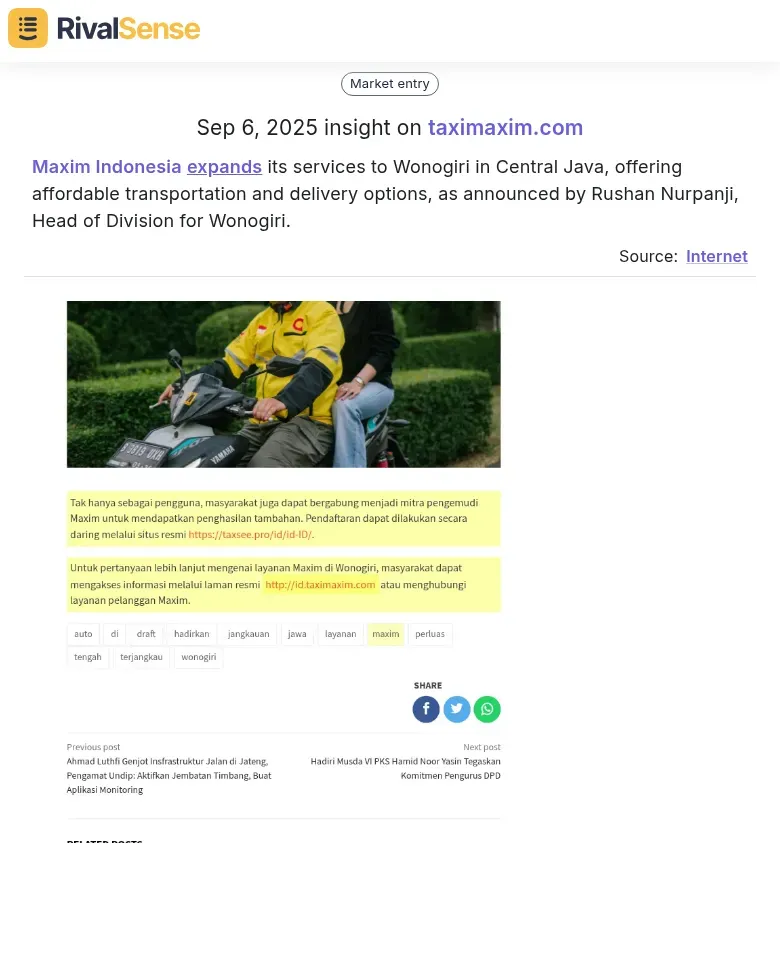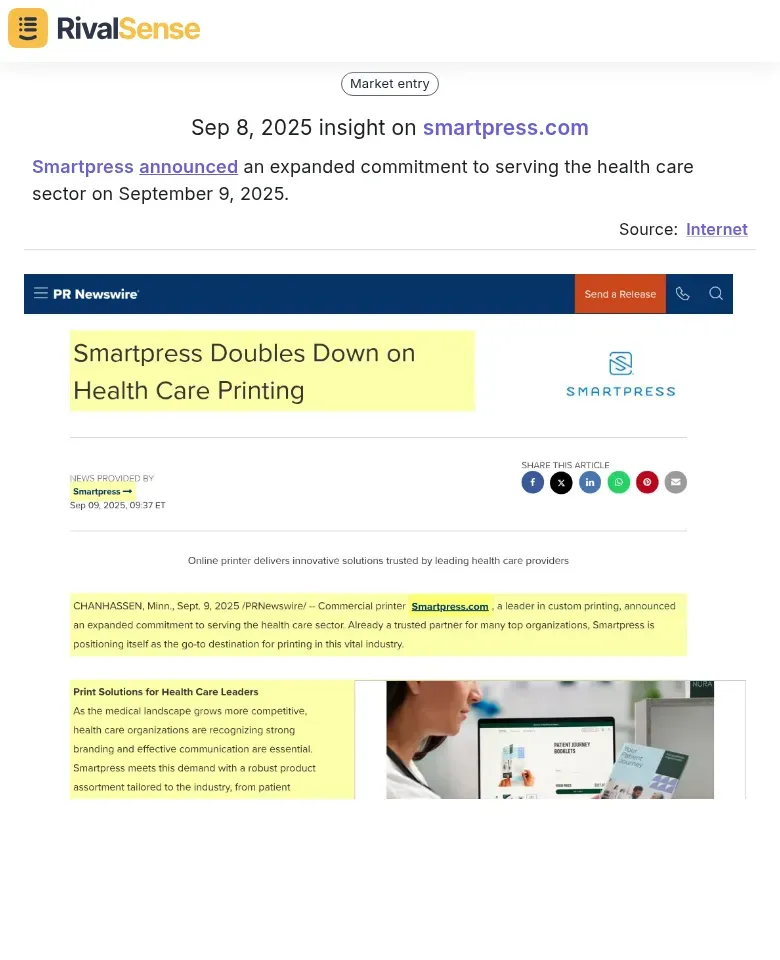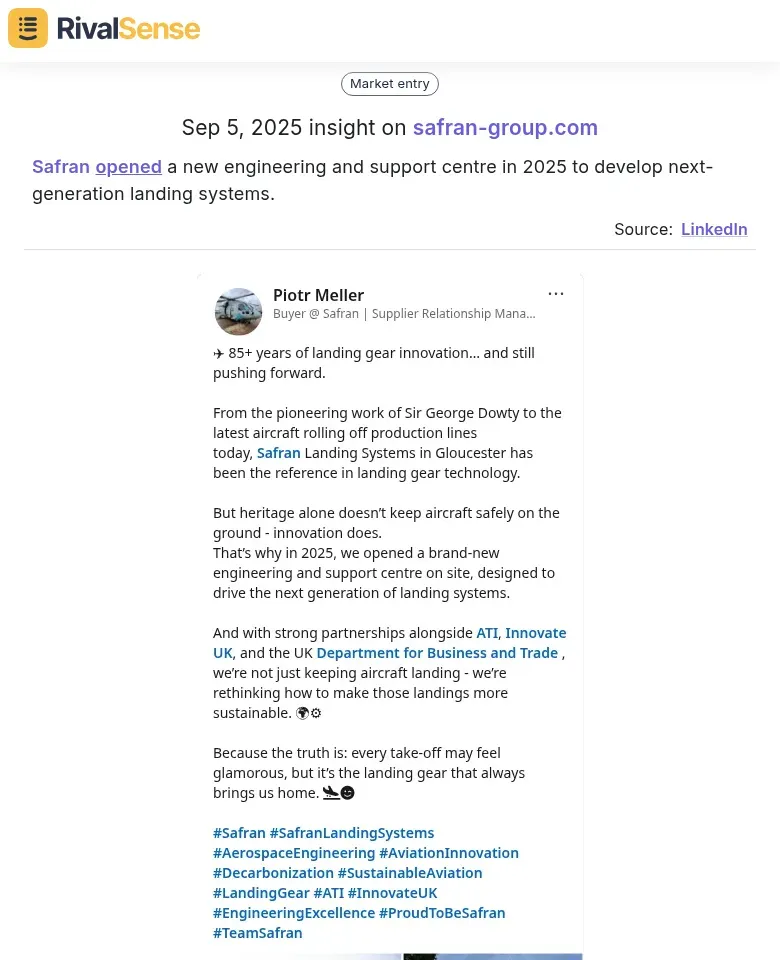Optimize Market Entry with Competitor Insights for Key Accounts
Market entry without competitor intelligence is like navigating a maze blindfolded—you might eventually succeed, but the risks are immense and the costs staggering. The strategic power of competitor insights transforms market entry from speculative guesswork into data-driven precision. By systematically tracking competitors' moves, pricing strategies, and customer engagements, you gain the intelligence needed to identify and secure key accounts before your rivals even know they're vulnerable.
Consider how market leaders leverage this advantage: Salesforce's expansion into new verticals consistently follows deep competitor analysis, identifying gaps in competitors' service offerings. HubSpot's international growth strategy relies on real-time tracking of local competitors' pricing and feature sets to position themselves optimally.
🚀 Practical steps to implement:
- Establish automated competitor tracking across websites, social media, and regulatory filings
- Map competitor key account relationships to identify at-risk clients
- Monitor competitor feature releases to anticipate market expectations
- Track pricing changes to position your offerings competitively
- Analyze competitor partnerships to identify potential alliance opportunities
This intelligence-driven approach reduces market entry risks by 40-60% according to industry studies, turning competitive threats into strategic advantages for securing your most valuable accounts.
Decoding Competitor Expansion Patterns for Market Opportunity Assessment
Competitor expansion signals provide invaluable intelligence for identifying untapped market opportunities. By systematically analyzing geographic movements, sector commitments, and service developments, you can pinpoint growth corridors and underserved customer segments.
🗺️ Geographic Expansion Analysis
Track competitor office openings, hiring patterns, and regional marketing investments. When competitors enter new territories, they often reveal validated market demand. Create a heat map of competitor density to identify underserved regions. For example, if three major competitors cluster in coastal cities while ignoring growing inland markets, you've found a potential expansion corridor.
Real-world example: Maxim Indonesia recently expanded its services to Wonogiri in Central Java, offering affordable transportation and delivery options. This type of geographic expansion insight can reveal emerging market opportunities and help you anticipate competitor moves in developing regions.

🏥 Sector-Specific Commitment Tracking
Monitor competitor R&D investments, partnership announcements, and executive hiring patterns. When competitors double down on specific verticals, they signal emerging opportunities. If a rival suddenly hires multiple healthcare specialists while launching healthcare-specific solutions, this indicates both market validation and potential saturation points to avoid.
Real-world example: Smartpress recently announced an expanded commitment to serving the healthcare sector. Tracking such sector-specific commitments helps you identify growing verticals and potential partnership opportunities before competitors dominate the space.

📊 Service Expansion Mapping
Analyze competitor feature releases, pricing tier changes, and customer success hiring. Service gaps often reveal unmet customer needs. When competitors add premium support tiers or industry-specific features, they're responding to market demands you could address more effectively.
✅ Practical Implementation Checklist:
- [ ] Set up automated alerts for competitor expansion announcements
- [ ] Use LinkedIn Sales Navigator to track competitor hiring patterns by location and department
- [ ] Create a competitor expansion dashboard with quarterly updates
- [ ] Conduct win/loss analysis with customers who chose expanding competitors
- [ ] Map competitor service offerings against customer pain points from reviews
Remember: The most valuable opportunities often exist at the intersection of competitor expansion patterns and customer frustration points. By decoding where competitors are investing—and where they're falling short—you can strategically position your market entry for maximum impact.
Leveraging Competitor Infrastructure Investments for Strategic Positioning
Competitor infrastructure investments reveal critical strategic insights for market positioning. When rivals announce facility expansions, analyze the location, capacity, and timeline to anticipate their market capacity and service capabilities. For example, a competitor building a new distribution center in a specific region signals planned market penetration there—adjust your strategy accordingly.
Real-world example: Safran opened a new engineering and support centre in 2025 to develop next-generation landing systems. Monitoring such infrastructure investments provides early warning of technological advancements and helps you anticipate competitor capabilities 12-18 months before product launches.

R&D center openings provide foresight into technological advancements. Track announcements of new research facilities, partnerships with universities, or hiring spikes in technical roles. These investments typically precede product launches by 12-18 months. Create a timeline mapping competitor R&D investments to forecast their innovation pipeline.
🔧 Practical steps:
- Monitor press releases and regulatory filings for facility announcements
- Analyze geographic patterns to identify target markets
- Estimate capacity increases from square footage data
- Track hiring patterns near new facilities
- Use satellite imagery tools to monitor construction progress
Infrastructure investments indicate strategic priorities—heavy manufacturing expansion suggests cost leadership goals, while R&D centers signal innovation focus. Adjust your positioning to exploit gaps or counter emerging threats.
Competitor Intelligence Frameworks for Key Account Targeting
To master key account targeting with competitor intelligence, implement these actionable frameworks:
🎯 Account-Based Intelligence Gathering Methodology
- Create detailed account profiles using win-loss analysis, customer interviews, and social listening
- Monitor competitor activities at target accounts through news alerts, LinkedIn tracking, and customer feedback
- Establish cross-functional intelligence sharing between sales, marketing, and customer success teams
- Use automated competitor monitoring tools for real-time account-level intelligence
🎯 Competitor Vulnerability Mapping
- Identify at-risk accounts by analyzing competitor service gaps, pricing changes, and customer satisfaction scores
- Map competitor weaknesses against your strengths using SWOT analysis for each target account
- Track competitor churn patterns and customer complaints to spot conversion opportunities
- Create vulnerability scoring system based on contract renewal dates, implementation issues, and feature gaps
🎯 Competitive Positioning Matrix
- Plot competitors against key dimensions: price vs. value, innovation vs. stability, customization vs. simplicity
- Use positioning grids to find open market space where you can dominate
- Develop "Best, Better, Only" framework: what you do exceptionally well, better than competitors, and uniquely
- Focus on 3-5 positioning vectors that matter most to your ideal accounts and where you can win
📋 Practical Checklist:
- [ ] Conduct quarterly competitor SWOT analysis for top 20 target accounts
- [ ] Set up alerts for competitor mentions at key accounts
- [ ] Create account-specific battle cards highlighting competitor vulnerabilities
- [ ] Train sales teams on positioning against specific competitors at each account
- [ ] Monitor competitor pricing changes and contract renewals for timing opportunities
Operationalizing Competitor Insights into Actionable Market Entry Plans
Operationalizing competitor insights transforms raw data into strategic market entry advantages. Start by mapping competitor weaknesses to your strengths—if rivals lack local support infrastructure, allocate resources to build superior customer service teams in target regions. Develop counter-strategies using SWOT analysis: when entering Asian markets, one SaaS company capitalized on competitors' slow localization by offering native-language support and culturally adapted pricing models.
Implement continuous monitoring systems with AI-powered tools to track real-time competitor movements. Set automated alerts for pricing changes, feature launches, or leadership shifts. Create a monthly competitive review cadence where cross-functional teams assess:
- New competitor marketing campaigns
- Customer review sentiment shifts
- Market share fluctuations
✅ Practical checklist:
- Assign ownership for each competitor monitoring channel
- Establish key performance indicators (KPIs) for counter-strategy effectiveness
- Integrate competitor alerts into your CRM for sales team readiness
- Conduct quarterly war-gaming sessions to simulate competitor responses
This proactive approach ensures your market entry plans remain agile and data-driven.
Measuring Success: KPIs and ROI of Competitor-Informed Market Entry
To measure the success of competitor-informed market entry, establish these KPIs and ROI calculations:
📊 Key Metrics to Track:
- Market Penetration Rate: (Your customers ÷ Total addressable market) × 100. Track monthly to see competitor intelligence impact
- Competitive Win Rate: Deals won against specific competitors ÷ Total competitive deals. Aim for 15-20% improvement
- Key Account Conversion Velocity: Days from first contact to closed deal. Competitor insights should reduce this by 25-30%
- Customer Acquisition Cost (CAC): Monitor for reduction as competitor intelligence improves targeting efficiency
💰 ROI Calculation Formula:
ROI = [(Revenue from competitor-informed deals + Risk mitigation savings) - CI investment] ÷ CI investment × 100
🚀 Practical Steps:
- Baseline current metrics before implementing competitor intelligence
- Tag deals where competitor insights were used in your CRM
- Calculate risk reduction by estimating avoided losses from competitor moves
- Track time savings in sales cycles - multiply by average deal size
- Use a weighted scoring system: 40% revenue impact, 30% risk reduction, 30% efficiency gains
Pro Tip: Create a competitor intelligence dashboard showing real-time impact on these metrics to demonstrate ongoing value to stakeholders.
Ready to Transform Your Market Entry Strategy?
Competitor intelligence isn't just nice to have—it's essential for successful market entry and key account acquisition. The insights you gain from tracking competitor movements, expansions, and investments can mean the difference between costly failures and strategic victories.
Try RivalSense for free and see how automated competitor tracking can revolutionize your market entry strategy. Get your first competitor report today at https://rivalsense.co/ and start making data-driven decisions that outmaneuver your competition.
📚 Read more
👉 How Fincantieri's Media Showcase Demonstrates Strategic Competitor Positioning
👉 Competitor Thought Leadership Analysis: The Ultimate 2025 Guide to Uncover Hidden Opportunities
👉 Predictive Monitoring: How Insurance Brokers Can Anticipate Competitor Moves
👉 Actionable Internet Monitoring Strategies for Competitor Press Releases
